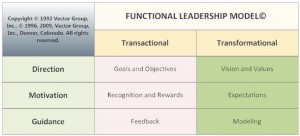FUNTIONAL LEADERSHIP MODEL©
The functional view assumes that leadership is defined by the relationship between the leader and a group—both the leader’s behavior and its effect on the group. Leadership is not inherent in the individual; it is neither a set of traits, nor something people are born with. Rather, it is something one provides to a group to meet certain needs. One cannot be a leader without a group that wants and will use what a leader can provide.
Both strategies are legitimate, depending on circumstances; and they are not incompatible. For example, in the process of making something work better, people often find ways to change it; and in the process of trying to redesign something, people may find a way to make the original item work better. A leader may operate in either or both of these modes.
Other writers have made this distinction between leadership strategies (Burns, 1978; Zaieznik, 1977). James McGregor Burns, (1978) for example, labels these two approaches as “transactional” and “transformative.” He describes the transactional approach (improve what you have) as characteristic of management, and the transformative approach (change it) as the key to leadership.
Transactional: people are motivated by recognition and reward (compensation, benefits, recognition). Contingent upon performance. “Do what I tell you to do and you will be allowed to work here and be paid.”
Transformational: People will follow someone who excites and inspires them. The leader is passionate, energetic, probably charismatic. “I see a bright future for us if we all pull together. We can change our future and life will be better.”
Charismatic leaders believe in themselves and not their followers. Narcissistic. Downside of transformational is that passion, commitment, energy, confidence can look like reality. Just because one believes something doesn’t make it so. Doesn’t get bogged down in the details.

